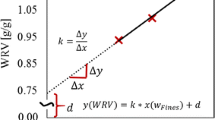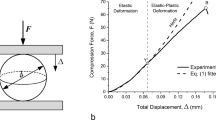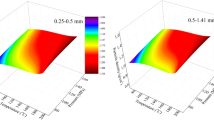Abstract
The basic principle of methods measuring water retention of fibre pulp was adapted for a new method to prove differences in polarity and particle size of wooden particles used for particle board production. With this new method, particles come into contact with the liquid for a short time. Besides the laboratory method, appropriate data analyses of the weight-time curves, including the calculation of a novel polarity coefficient are introduced. The measurement signal was found to be most significantly influenced by the particle properties at the equilibrium of liquid charge and discharge, as well as within the asymptotic levelling phase around 30 s of testing. With increasing particle size, water retention values of both native and thermally modified particles decrease due to reduced specific particle surface. Thermally modified particles show significantly lower water retention values in the range of −28 to −46 % and higher variability which is thought to be related to reduced polarity. The method proved to be quick, easy to handle and reproducible.
Zusammenfassung
Das Grundprinzip von Messmethoden zur Bestimmung des Wasserrückhaltevermögens von Zellstoff wurde für eine neue Messmethode adaptiert, um an Holzspänen, welche in der Spanplattenproduktion verwendet werden, Polaritäts- und Größeneffekte zu erfassen. Bei dieser neuen Methode kommen die Partikel nur kurze Zeit in Kontakt mit der Flüssigkeit. Neben der Labormethode wird auch eine geeignete Methode für die Datenanalyse der Masse-Zeit-Kurven, inklusive einem neu kreierten Polaritätskoeffizienten vorgestellt. Das Messsignal wird im Gleichgewicht zwischen Zu- und Ablauf der Flüssigkeit sowie im asymptotischen Bereich nach etwa 30 s Testdauer am signifikantesten durch die Partikeleigenschaften beeinflusst. Mit zunehmender Spangröße nimmt das Wasserrückhaltevermögen von unbehandelten und thermisch modifizierten Spänen aufgrund der geringeren spezifischen Partikeloberfläche ab. Thermisch modifizierte Späne zeigen aufgrund der geringeren Polarität ein reduziertes Wasserrückhaltevermögen in der Größenordnung von −28 bis −46 % und eine höhere Variabilität des Messsignals. Die Methode ist schnell, leicht zu handhaben und reproduzierbar.



Similar content being viewed by others
References
Chen H, Park A, Heitmann JA, Hubbe MA (2009) Importance of cellulosic fines relative to the dewatering rates of fiber suspensions. Ind Eng Chem Res 48:9106–9112
Dienes D, Kemény S, Egyházi A, Réczey K (2005) Improving the capability of the Schopper-Riegler freeness measurement. Measurement 38:194–203
García O, Torres AL, Colom JF, Pastor FIJ, Díaz P, Vidal T (2002) Effect of cellulase-assisted refining on the properties of dried and never-dried eucalyptus pulp. Cellulose 9:115–125
ISO (1999) ISO 5267-1 Pulps—determination of drainability—Part 1: Schopper-Riegler method. International Organization for Standardization, Genève
Lips SJJ, Iñiguez de Heredia GM, Op den Kamp RGM, van Dam JEG (2009) Water adsorption characteristics of kenaf core to use as animal bedding material. Ind Crop Prod 29:73–79
Merkblatt IV/33/1957 (1957) Bestimmung des Wasserrückhaltevermögens (Quellwert) von Zellstoffen. Verein der Zellstoff- und Papier-Chemiker und –ingenieure, Darmstadt
Oksanen T, Pere J, Bucher J, Viikari L (1997) The effect of Trichoderma reesei cellulases and hemicellulases on the paper technical properties of never-dried bleached kraft pulp. Cellulose 4:329–339
Pan M, Zhou D, Zhou X, Lian Z (2010) Improvement of straw surface characteristics via thermochemical and chemical treatments. BioresourTechnol 101:7930–7934
Roffael E, Kraft R (2011) Einfluss der thermischen Modifizierung von Holz auf das Wasserrückhaltevermögen (WRV-Wert). Eur J Wood Prod 70(1–3):393–395
TAPPI UM 256 (1991) Water retention value (WRV). 54–55
Vincentim MP, Ferraz A (2008) Alkaline-sulfit chemithermomechanical pulping of Eucalyptus grandis biotreated by Ceriporiopsis subvermispora varied culture conditions. Holzforschung 62:375–382
Vincentim MP, de Almeida Faria R, Ferraz A (2009) High-yield kraft pulping of Eucalyptus grandis Hill ex Maiden biotreated by Ceriporiopsis subvermispora under two different conditions. Holzforschung 63:408–413
Acknowledgments
This work was funded by the Austrian Government and the federal governments of Upper Austria, Lower Austria, and Carinthia within the COMET-program.
Author information
Authors and Affiliations
Corresponding author
Rights and permissions
About this article
Cite this article
Weigl, M., Schmidberger, C. & Müller, U. Water retention of wood particles – characterization of polarity and particle size. Eur. J. Wood Prod. 71, 147–151 (2013). https://doi.org/10.1007/s00107-012-0634-7
Received:
Published:
Issue Date:
DOI: https://doi.org/10.1007/s00107-012-0634-7




